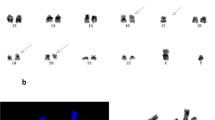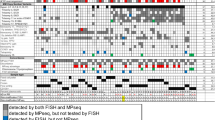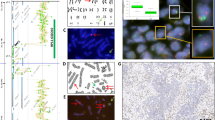Abstract
Fluorescence in situ hybridization (FISH) analysis has shown previously that 10–15% of chronic myeloid leukemias (CML) have hemizygous deletions of variable sizes affecting regions that flank the ABL and BCR translocation breakpoints on the derivative chromosome 9, and these patients have a poor outcome. FISH studies using large commercial genomic probes have previously suggested that haploinsufficiency of sequences flanking either ABL or BCR modify the disease process of CML and lead to an unfavorable prognosis. In this present study, real-time quantitative PCR (Q-PCR) analysis was used to identify and map much smaller hemizygous microdeletions in a subset of CML patients that were not deleted using large genomic FISH probes. Microdeletions were identified by Q-PCR in 25 of 71 patients selected based on less favorable outcome (chronic phase duration of less than 96 months and a survival time of less than 84 months). In contrast, no microdeletion was detected in any of 18 CML samples selected from a group with a more favorable outcome. Detailed mapping of the 25 Q-PCR microdeletions showed that the minimal deleted region extended ∼120 kb from the 5′ end of the ABL gene in the centromeric direction on the derivative chromosome 9, and the region 3′ to BCR on chromosome 22 was excluded. Of the four ESTs and/or genes that map to the 120 kb region, the putative tumor suppressor PRDM12 is the strongest candidate gene. The potential role for each sequence in modifying the clinical behavior of CML is presented.
This is a preview of subscription content, access via your institution
Access options
Subscribe to this journal
Receive 12 print issues and online access
$259.00 per year
only $21.58 per issue
Buy this article
- Purchase on Springer Link
- Instant access to full article PDF
Prices may be subject to local taxes which are calculated during checkout





Similar content being viewed by others
References
Puil L, Liu J, Gish G, Mbamalu G, Bowtell D, Pelicci PG et al. Bcr–Abl oncoproteins bind directly to activators of the Ras signalling pathway. EMBO J 1994; 13: 764–773.
Horita M, Andreu EJ, Benito A, Arbona C, Sanz C, Benet I et al. Blockade of the Bcr–Abl kinase activity induces apoptosis of chronic myelogenous leukemia cells by suppressing signal transducer and activator of transcription 5-dependent expression of Bcl-xL. J Exp Med 2000; 191: 977–984.
Bedi A, Zehnbauer BA, Barber JP, Sharkis SJ, Jones RJ . Inhibition of apoptosis by BCR–ABL in chronic myeloid leukemia. Blood 1994; 83: 2038–2044.
Bedi A, Barber JP, Bedi GC, el-Deiry WS, Sidransky D, Vala MS et al. BCR–ABL-mediated inhibition of apoptosis with delay of G2/M transition after DNA damage: a mechanism of resistance to multiple anticancer agents. Blood 1995; 86: 1148–1158.
Gordon MY, Dowding CR, Riley GP, Goldman JM, Greaves MF . Altered adhesive interactions with marrow stroma of haematopoietic progenitor cells in chronic myeloid leukaemia. Nature 1987; 328: 342–344.
Salgia R, Li JL, Ewaniuk DS, Pear W, Pisick E, Burky SA et al. BCR/ABL induces multiple abnormalities of cytoskeletal function. J Clin Invest 1997; 100: 46–57.
Weisberg E, Sattler M, Ewaniuk DS, Salgia R . Role of focal adhesion proteins in signal transduction and oncogenesis. Crit Rev Oncog 1997; 8: 343–358.
Bhatia R, Munthe HA, Verfaillie CM . Role of abnormal integrin–cytoskeletal interactions in impaired beta1 integrin function in chronic myelogenous leukemia hematopoietic progenitors. Exp Hematol 1999; 27: 1384–1396.
Pasternak G, Hochhaus A, Schultheis B, Hehlmann R . Chronic myelogenous leukemia: molecular and cellular aspects. J Cancer Res Clin Oncol 1998; 124: 643–660.
Sokal JE, Baccarani M, Russo D, Tura S . Staging and prognosis in chronic myelogenous leukemia. Semin Hematol 1988; 25: 49–61.
Savage DG, Szydlo RM, Goldman JM . Clinical features at diagnosis in 430 patients with chronic myeloid leukaemia seen at a referral centre over a 16-year period. Br J Haematol 1997; 96: 111–116.
Sawyers CL . Chronic myeloid leukemia. N Engl J Med 1999; 340: 1330–1340.
Faderl S, Talpaz M, Estrov Z, Kantarjian HM . Chronic myelogenous leukemia: biology and therapy. Ann Intern Med 1999; 131: 207–219.
Kantarjian HM, Talpaz M . Definition of the accelerated phase of chronic myelogenous leukemia [letter]. J Clin Oncol 1988; 6: 180–182.
Nowell PC . Progress with Chronic Myelogenous Leukemia: A Personal Perspective over Four Decades. Annu Rev Med 2002; 53: 1–13.
Weisberg E, Griffin JD . Mechanism of resistance to the ABL tyrosine kinase inhibitor STI571 in BCR/ABL-transformed hematopoietic cell lines. Blood 2000; 95: 3498–3505.
Hochhaus A, Kreil S, Corbin AS, La Rosee P, Muller MC, Lahaye T et al. Molecular and chromosomal mechanisms of resistance to imatinib (STI571) therapy. Leukemia 2002; 16: 2190–2196.
le Coutre P, Tassi E, Varella-Garcia M, Barni R, Mologni L, Cabrita G et al. Induction of resistance to the Abelson inhibitor STI571 in human leukemic cells through gene amplification. Blood 2000; 95: 1758–1766.
Mahon FX, Deininger MW, Schultheis B, Chabrol J, Reiffers J, Goldman JM, Melo JV . Selection and characterization of BCR–ABL positive cell lines with differential sensitivity to the tyrosine kinase inhibitor STI571: diverse mechanisms of resistance. Blood 2000; 96: 1070–1079.
Gorre ME, Mohammed M, Ellwood K, Hsu N, Paquette R, Rao PN, Sawyers CL . Clinical resistance to STI-571 cancer therapy caused by BCR–ABL gene mutation or amplification. Science 2001; 293: 876–880.
Markovic VD, Bouman D, Bayani J, Al-Maghrabi J, Kamel-Reid S, Squire JA . Lack of BCR/ABL reciprocal fusion in variant Philadelphia chromosome translocations: a use of double fusion signal FISH and spectral karyotyping [letter]. Leukemia 2000; 14: 1157–1160.
Kolomietz E, Al-Maghrabi J, Brennan S, Karaskova J, Minkin S, Lipton J, Squire JA . Primary chromosomal rearrangements of leukemia are frequently accompanied by extensive submicroscopic deletions and may lead to altered prognosis. Blood 2001; 97: 3581–3588.
Grand F, Kulkarni S, Chase A, Goldman JM, Gordon M, Cross NC . Frequent deletion of hSNF5/INI1, a component of the SWI/SNF complex, in chronic myeloid leukemia. Cancer Res 1999; 59: 3870–3874.
Sinclair PB, Nacheva EP, Leversha M, Telford N, Chang J, Reid A et al. Large deletions at the t(9; 22) breakpoint are common and may identify a poor-prognosis subgroup of patients with chronic myeloid leukemia. Blood 2000; 95: 738–743.
Huntly BJ, Reid AG, Bench AJ, Campbell LJ, Telford N, Shepherd P, Szer J et al. Deletions of the derivative chromosome 9 occur at the time of the Philadelphia translocation and provide a powerful and independent prognostic indicator in chronic myeloid leukemia. Blood 2001; 98: 1732–1738.
Laurendeau I, Bahuau M, Vodovar N, Larramendy C, Olivi M, Bieche I et al. TaqMan PCR-based gene dosage assay for predictive testing in individuals from a cancer family with INK4 locus haploinsufficiency. Clin Chem 1999; 45: 982–986.
Aarskog NK, Vedeler CA . Real-time quantitative polymerase chain reaction. A new method that detects both the peripheral myelin protein 22 duplication in Charcot–Marie–Tooth type 1A disease and the peripheral myelin protein 22 deletion in hereditary neuropathy with liability to pressure palsies. Hum Genet 2000; 107: 494–498.
Wilke K, Duman B, Horst J . Diagnosis of haploidy and triploidy based on measurement of gene copy number by real-time PCR. Hum Mutat 2000; 16: 431–436.
Ruiz-Ponte C, Loidi L, Vega A, Carracedo A, Barros F . Rapid real-time fluorescent PCR gene dosage test for the diagnosis of DNA duplications and deletions. Clin Chem 2000; 46: 1574–1582.
AppliedBiosystems. The SYBR® Green PCR Master Mix and RT-PCR Protocol (P/N 4310251). 2002. http://docs.appliedbiosystems.com/;pebiodocss/04310251.pdf
AppliedBiosystems. The SYBR® Green PCR and RT-PCR Reagents Protocol (P/N 4304965). 2002. http://docs.appliedbiosystems.com/;pebiodocss/04304965.pdf
Rajeevan MS, Ranamukhaarachchi DG, Vernon SD, Unger ER . Use of real-time quantitative PCR to validate the results of cDNA array and differential display PCR technologies. Methods 2001; 25: 443–451.
Heid CA, Stevens J, Livak KJ, Williams PM . Real time quantitative PCR. Genome Res 1996; 6: 986–994.
Bassler HA, Flood SJ, Livak KJ, Marmaro J, Knorr R, Batt CA . Use of a fluorogenic probe in a PCR-based assay for the detection of Listeria monocytogenes. Appl Environ Microbiol 1995; 61: 3724–3728.
Orlando C, Pinzani P, Pazzagli M . Developments in quantitative PCR. Clin Chem Lab Med 1998; 36: 255–269.
Boulay JL, Reuter J, Ritschard R, Terracciano L, Herrmann R, Rochlitz C . Gene dosage by quantitative real-time PCR. Biotechniques 1999; 27: 228–230, 232.
Higuchi R, Fockler C, Dollinger G, Watson R . Kinetic PCR analysis: real-time monitoring of DNA amplification reactions. Biotechnology (NY) 1993; 11: 1026–1030.
Qi L, Sit KH . Suicidal differential housekeeping gene activity in apoptosis induced by DCNP. Apoptosis 2000; 5: 379–388.
System APSD. Relative Quantitation Of Gene Expression: User Bulletin #2: Rev B. PE Applied Biosystems; 1997, updated 2001. http://docs.applied.biosystems.com/pebiodoccs/04303859.pdf
Livak KJ . Comparative Ct Method. ABI PRISM 7700 Sequence Detection System. User Bulletin No. 2. Relative Quantitation of Gene Expression. PE Applied Biosystems, 1997. http://docs.appliedbiosystems.com/pebioodocs/04303859.pdf
Uphoff CC, Habig S, Fombonne S, Matsuo Y, Drexler HG . ABL–BCR expression in BCR–ABL-positive human leukemia cell lines. Leuk Res 1999; 23: 1055–1060.
Melo JV, Gordon DE, Cross NC, Goldman JM . The ABL-BCR fusion gene is expressed in chronic myeloid leukemia. Blood 1993; 81(1): 158–165.
Aatsinki JT, Lakkakorpi JT, Pietila EM, Rajaniemi HJ . A coupled one-step reverse transcription PCR procedure for generation of full-length open reading frames. Biotechniques 1994; 16: 282–284, 286–288.
Sellner LN, Turbett GR . Comparison of three RT-PCR methods. Biotechniques 1998; 25: 230–234.
Bruce BEG, Phil H, Sue K, Rick M . Computational analysis of DNA and protein sequences. In: GENOME Analysis: A Laboratory Manual Series (Chapter 7). http://www.cshl.org/books/g_a/indxbk1.htm.
Dewald GW, Wyatt WA, Silver RT . Atypical BCR and ABL D-FISH patterns in chronic myeloid leukemia and their possible role in therapy. Leuk Lymphoma 1999; 34: 481–491.
MacKenzie E, Stewart E, Birnie GD . ABL-BCR mRNAs transcribed from chromosome 9q+ in Philadelphia-chromosome-positive chronic myeloid leukaemia. Leukemia 1993; 7: 702–706.
Loncarevic IF, Romer J, Starke H, Heller A, Bleck C, Ziegler M et al. Heterogenic molecular basis for loss of ABL1-BCR transcription: Deletions in der(9)t(9; 22) and variants of standard t(9; 22) in BCR-ABL1-positive chronic myeloid leukemia. Genes Chromosomes Cancer 2002; 34: 193–200.
de la Fuente J, Merx K, Steer EJ, Muller M, Szydlo RM, Maywald O et al. ABL–BCR expression does not correlate with deletions on the derivative chromosome 9 or survival in chronic myeloid leukemia. Blood 2001; 98: 2879–2880.
Huntly BJ, Bench AJ, Delabesse E, Reid AG, Li J, Scott MA et al. Derivative chromosome 9 deletions in chronic myeloid leukemia: poor prognosis is not associated with loss of ABL-BCR expression, elevated BCR-ABL levels, or karyotypic instability. Blood 2002; 99: 4547–4553.
Asimakopoulos FA, Shteper PJ, Krichevsky S, Fibach E, Polliack A, Rachmilewitz E et al. ABL1 methylation is a distinct molecular event associated with clonal evolution of chronic myeloid leukemia. Blood 1999; 94: 2452–2460.
Sun B, Jiang G, Zaydan MA, La Russa VF, Safah H, Ehrlich M . ABL1 promoter methylation can exist independently of BCR–ABL transcription in chronic myeloid leukemia hematopoietic progenitors. Cancer Res 2001; 61: 6931–6937.
Yin JL, Williams BG, Arthur CK, Ma DD . Interferon response in chronic myeloid leukaemia correlates with ABL/BCR expression: a preliminary study. Br J Haematol 1995; 89: 539–545.
Takita J, Hayashi Y, Kohno T, Yamaguchi N, Hanada R, Yamamoto K, Yokota J . Deletion map of chromosome 9 and p16 (CDKN2A) gene alterations in neuroblastoma. Cancer Res 1997; 57: 907–912.
Mitchell P, Petfalski E, Shevchenko A, Mann M, Tollervey D . The exosome: a conserved eukaryotic RNA processing complex containing multiple 3′→5′ exoribonucleases. Cell 1997; 91: 457–466.
Mitchell P, Petfalski E, Tollervey D . The 3′ end of yeast 5.8S rRNA is generated by an exonuclease processing mechanism. Genes Dev 1996; 10: 502–513.
Chen CY, Gherzi R, Ong SE, Chan EL, Raijmakers R, Pruijn GJ et al. AU binding proteins recruit the exosome to degrade ARE-containing mRNAs. Cell 2001; 107: 451–464.
Jenuwein T, Laible G, Dorn R, Reuter G . SET domain proteins modulate chromatin domains in eu- and heterochromatin. Cell Mol Life Sci 1998; 54: 80–93.
Steele-Perkins G, Fang W, Yang XH, Van Gele M, Carling T, Gu J et al. Tumor formation and inactivation of RIZ1, an Rb-binding member of a nuclear protein-methyltransferase superfamily. Genes Dev 2001; 15: 2250–2262.
Mitelman F . Catalog of Chromosome Aberrations in Cancer, 5th edn. New York: Wiley-Liss, 1994.
Mitelman F . Recurrent chromosome aberrations in cancer. Mutat Res 2000; 462: 247–253.
Offit K, Parsa NZ, Jhanwar SC, Filippa D, Wachtel M, Chaganti RS . Clusters of chromosome 9 aberrations are associated with clinico-pathologic subsets of non-Hodgkin's lymphoma. Genes Chromosomes Cancer 1993; 7: 1–7.
Yang X, Shen P, Yao K, Mi Z, Liu S, Zhang H et al. High frequency loss of heterozygosity in the region of the DBH locus in bladder cancer. Chin Med J (Engl) 2000; 113: 117–119.
Orlow I, Lianes P, Lacombe L, Dalbagni G, Reuter VE, Cordon-Cardo C . Chromosome 9 allelic losses and microsatellite alterations in human bladder tumors. Cancer Res 1994; 54: 2848–2851.
Edwards J, Duncan P, Going JJ, Grigor KM, Watters AD, Bartlett JM . Loss of heterozygosity on chromosomes 11 and 17 are markers of recurrence in TCC of the bladder. Br J Cancer 2001; 85: 1894–1899.
Rao PH, Harris CP, Yan Lu X, Li XN, Mok SC, Lau CC . Multicolor spectral karyotyping of serous ovarian adenocarcinoma. Genes Chromosomes Cancer 2002; 33: 123–132.
Devlin J, Elder PA, Gabra H, Steel CM, Knowles MA . High frequency of chromosome 9 deletion in ovarian cancer: evidence for three tumour-suppressor loci. Br J Cancer 1996; 73: 420–423.
Schultz DC, Vanderveer L, Buetow KH, Boente MP, Ozols RF, Hamilton TC, Godwin AK . Characterization of chromosome 9 in human ovarian neoplasia identifies frequent genetic imbalance on 9q and rare alterations involving 9p, including CDKN2. Cancer Res 1995; 55: 2150–2157.
Goeze A, Schluns K, Wolf G, Thasler Z, Petersen S, Petersen I . Chromosomal imbalances of primary and metastatic lung adenocarcinomas. J Pathol 2002; 196: 8–16.
Shao JY, Wang HY, Huang XM, Feng QS, Huang P, Feng BJ et al. Genome-wide allelotype analysis of sporadic primary nasopharyngeal carcinoma from southern China. Int J Oncol 2000; 17: 1267–1275.
Acknowledgements
We are indebted to Jane Bayani and Dr Dwayne Barber for critically reviewing this manuscript and to the staff of the Cancer Cytogenetics Program and the Molecular Diagnostics Laboratory at the Banting Institute for their assistance. This work was supported by Leukemia Research Fund of Canada. EK is a recipient of the Governor General's Fellowship for Leukemia Research from the Leukemia Research Fund of Canada.
Author information
Authors and Affiliations
Rights and permissions
About this article
Cite this article
Kolomietz, E., Marrano, P., Yee, K. et al. Quantitative PCR identifies a minimal deleted region of 120 kb extending from the Philadelphia chromosome ABL translocation breakpoint in chronic myeloid leukemia with poor outcome. Leukemia 17, 1313–1323 (2003). https://doi.org/10.1038/sj.leu.2402969
Received:
Accepted:
Published:
Issue Date:
DOI: https://doi.org/10.1038/sj.leu.2402969
Keywords
This article is cited by
-
VNTR polymorphism in the breakpoint region of ABL1 and susceptibility to bladder cancer
BMC Medical Genomics (2021)
-
MLL2/KMT2D and MLL3/KMT2C expression correlates with disease progression and response to imatinib mesylate in chronic myeloid leukemia
Cancer Cell International (2018)
-
An emerging role for prdm family genes in dorsoventral patterning of the vertebrate nervous system
Neural Development (2015)
-
Context-specific regulation of cancer epigenomes by histone and transcription factor methylation
Oncogene (2014)
-
Chromosome anomalies in bone marrow as primary cause of aplastic or hypoplastic conditions and peripheral cytopenia: disorders due to secondary impairment of RUNX1 and MPL genes
Molecular Cytogenetics (2012)



